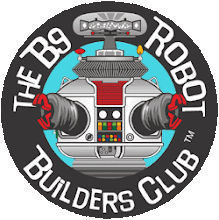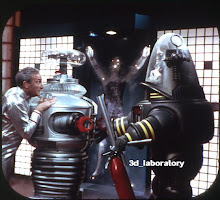OK, fair warning now... the further we go up, the more complicated the electronics become... sort of...Again, this is what I did. There are several ways to "skin a cat" and this is one of them......
My hip section moves up and down to simulate a power failure from a power pack pull out as well as to bow to pick things up, address royalty, etc. The motor to rotate the torso is also located in the hip section. This is a departure from Mike Joyce's replica robot where the waist rotation motor is actualy inside the torso. The motors used for both the hip and waist rotation is the Dewert 24v motors. Each one is controlled by a Vantec RET 411P single motor controller . These plug in to the RC receiver. I fused each RET 411p to protect it from any overload or spike from the batteries, etc. The manual for the RET 411P is located on the Vantec web site at http://www.vantec.com/retman98d.pdf. It is a very straight forward wiring procedure where the positive and negative leads of the motor are connected to the white and gray wires of the vantec controller. The black and orange wires go to the positive and negative leads of the battery. Note where the switch goes. I will use one of the switches inside of the programming bay to control hip and waist rotation. By switching them off I could save on battery power consumption and also serve as a safety control mechanism if I wanted to limit movement of my robot.
. These plug in to the RC receiver. I fused each RET 411p to protect it from any overload or spike from the batteries, etc. The manual for the RET 411P is located on the Vantec web site at http://www.vantec.com/retman98d.pdf. It is a very straight forward wiring procedure where the positive and negative leads of the motor are connected to the white and gray wires of the vantec controller. The black and orange wires go to the positive and negative leads of the battery. Note where the switch goes. I will use one of the switches inside of the programming bay to control hip and waist rotation. By switching them off I could save on battery power consumption and also serve as a safety control mechanism if I wanted to limit movement of my robot.
My hip section moves up and down to simulate a power failure from a power pack pull out as well as to bow to pick things up, address royalty, etc. The motor to rotate the torso is also located in the hip section. This is a departure from Mike Joyce's replica robot where the waist rotation motor is actualy inside the torso. The motors used for both the hip and waist rotation is the Dewert 24v motors. Each one is controlled by a Vantec RET 411P single motor controller
 . These plug in to the RC receiver. I fused each RET 411p to protect it from any overload or spike from the batteries, etc. The manual for the RET 411P is located on the Vantec web site at http://www.vantec.com/retman98d.pdf. It is a very straight forward wiring procedure where the positive and negative leads of the motor are connected to the white and gray wires of the vantec controller. The black and orange wires go to the positive and negative leads of the battery. Note where the switch goes. I will use one of the switches inside of the programming bay to control hip and waist rotation. By switching them off I could save on battery power consumption and also serve as a safety control mechanism if I wanted to limit movement of my robot.
. These plug in to the RC receiver. I fused each RET 411p to protect it from any overload or spike from the batteries, etc. The manual for the RET 411P is located on the Vantec web site at http://www.vantec.com/retman98d.pdf. It is a very straight forward wiring procedure where the positive and negative leads of the motor are connected to the white and gray wires of the vantec controller. The black and orange wires go to the positive and negative leads of the battery. Note where the switch goes. I will use one of the switches inside of the programming bay to control hip and waist rotation. By switching them off I could save on battery power consumption and also serve as a safety control mechanism if I wanted to limit movement of my robot.



 The Vantec controller connects to the RC receiver with 2 servo like connections; 1 marked with a "T" for throttle and another with a "S" for steering. Plug those into the corresponding slots on the receiver and you are ready to learn how to drive your "bucket of bolts". [As a side note make sure you do not adjust your power curve for forward or reverse throttle. Try it out at its default setting first. You don't want your "bubble headed booby" popping wheelies or doing somersaults!] The website for the Vantec Manual is this:
The Vantec controller connects to the RC receiver with 2 servo like connections; 1 marked with a "T" for throttle and another with a "S" for steering. Plug those into the corresponding slots on the receiver and you are ready to learn how to drive your "bucket of bolts". [As a side note make sure you do not adjust your power curve for forward or reverse throttle. Try it out at its default setting first. You don't want your "bubble headed booby" popping wheelies or doing somersaults!] The website for the Vantec Manual is this: 














































